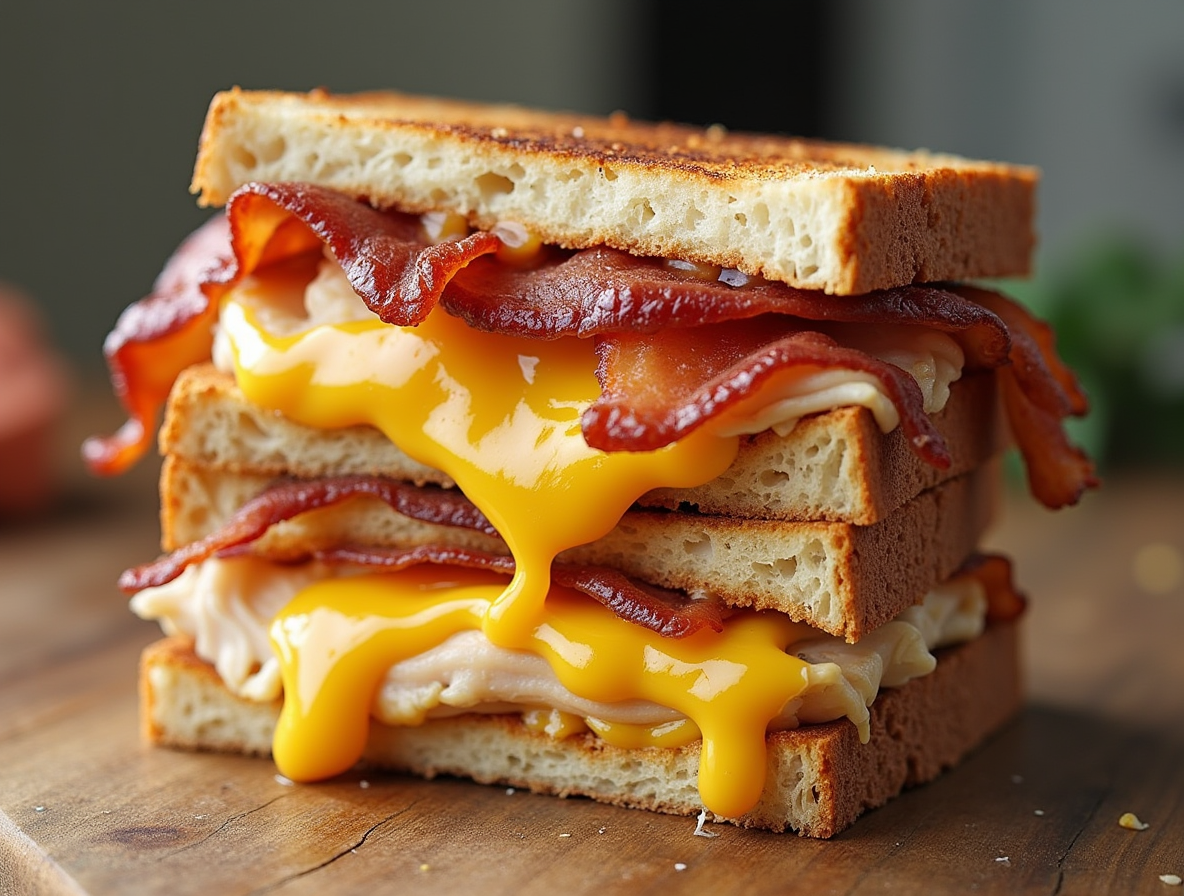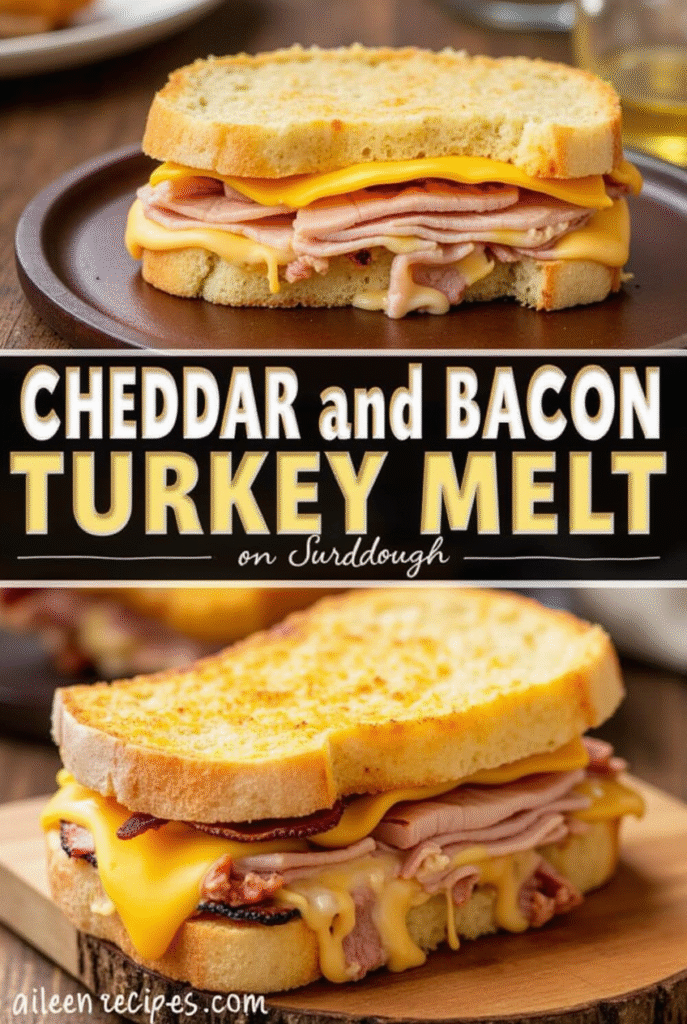The Secret to Making the Perfect Turkey Cheddar Melt (Better Than Restaurant)
A perfectly crafted turkey cheddar melt delivers 604 calories of pure comfort in every bite. During my culinary school days, this gourmet grilled cheese became my go-to comfort food—combining crispy bacon, creamy cheese, and tender turkey in a harmonious balance of textures. What makes our turkey melt recipe special? It’s ready in under 15 minutes, making it perfect for busy weeknights when you crave something satisfying.
I’ve discovered that using mayonnaise instead of butter actually creates a lighter sandwich with a beautifully golden exterior. Additionally, covering the skillet while cooking helps the cheese melt faster for that perfect gooey consistency we all love. Whether you’re transforming leftover deli turkey into a sustainable meal or creating a bacon turkey cheddar melt to satisfy hearty appetites, this versatile sandwich certainly allows for endless customization. From sourdough turkey melt variations to different cheese options, we’ll explore how to create a sandwich that’s undoubtedly better than anything you’d find at a restaurant.
Choosing the Right Ingredients for a Perfect Turkey Cheddar Melt
The foundation of any extraordinary turkey cheddar melt lies in selecting premium ingredients that work harmoniously together. From the crunch of the bread to the gooey perfection of melted cheese, each component plays a crucial role in creating sandwich magic.
Best bread types for texture and flavor
The bread selection makes or breaks your turkey cheddar melt experience. Sourdough stands out as a top choice with its distinctive tang and interesting texture. Its crusty exterior and soft interior create the perfect contrast when toasted. Alternatively, ciabatta offers a soft interior with a wonderfully chewy crust, making it excellent for warm sandwiches.
Other stellar options include:
- Seven-grain or whole wheat for a nutritious base
- Rye bread for a more robust flavor profile
- Brioche for a buttery, rich foundation
For the absolute best results, look for bread that’s “crusty on the outside and soft on the inside”. This structure ensures your sandwich maintains integrity while developing that irresistible golden crunch.
Cheddar cheese: sharp, mild, or smoked?
Although all varieties deliver delicious results, mild cheddar emerges as the champion for melting. Since it’s only aged for a few months, mild cheddar retains more moisture, creating that picture-perfect, stretchy melt. In contrast, extra sharp cheddar, aged for about a year, offers a more intense flavor but doesn’t melt as smoothly due to its drier composition.
For the best of both worlds, try this clever technique: “layer both components for a tasty, melty mashup”. Place thinly shaved sharp cheddar as your base, then cover with mild cheddar to help everything melt beautifully. Smoked cheddar offers another delicious alternative, adding depth without sacrificing meltability.
Deli turkey vs. leftover roast turkey
While convenient deli turkey works wonderfully, roasting your own turkey breast at home yields superior results. Homemade roasted turkey is “easy, relatively fast, very affordable, and the quality won’t just rival your favorite deli, but will probably surpass it”.
The secret? “Lots of seasoning and not a lot of overcooking”. Use a probe thermometer to ensure your turkey breast doesn’t exceed 150°F for optimal juiciness. Furthermore, thinly sliced turkey works best—don’t hesitate to ask your deli counter to slice it “as thin as possible”.
Optional add-ins: bacon, spinach, tomato, avocado
Elevate your turkey cheddar melt with thoughtful additions. Crispy bacon adds a savory crunch that complements the tender turkey. Fresh spinach provides a nutritious element that “blends with the spread in quite a nice way”, withstanding heat better than lettuce.
Ripe tomato slices contribute juiciness, particularly vine-ripened or beefsteak varieties. For additional creaminess, avocado makes an excellent addition. Finally, consider unexpected enhancements like caramelized onions or candied jalapeños for a sweet-spicy kick.
Step-by-Step Guide to Assembling and Cooking
Creating the perfect turkey cheddar melt is both an art and a science. With proper technique, you’ll achieve that golden-brown exterior and gooey interior that makes this sandwich irresistible.
1. Prepping your ingredients
Initially, wash and dry all produce if using vegetables like tomatoes or spinach. Next, prepare any spreads—combining honey with mustard creates a delightful sweet-savory base. For optimal melting, consider grating harder cheeses like cheddar rather than using slices. If using bacon, cook it until crispy and drain on paper towels before assembly. Allow butter to soften at room temperature for easier spreading.
2. Layering for optimal melt and crunch
The order of components significantly impacts your sandwich’s success. Place cheese directly next to the bread for the best melt—it acts as “glue” for other ingredients. For a turkey bacon melt, position the turkey slices over the cheese, followed by any vegetables or spreads. Specifically, place spinach near creamy spreads as “it blends with the spread in quite a nice way”. This strategic layering prevents ingredients from falling out and ensures even heating.
3. Buttering and grilling techniques
For the crispiest exterior, spread butter generously on the outside of both bread slices. At this point, many chefs recommend using 1/2 tablespoon of butter per side. Alternatively, mayonnaise creates an excellent golden crust with a higher smoke point than butter. For extra flavor, some recipes combine mayo with Dijon mustard as a spread on the inside of the bread.
4. Using a skillet vs. panini press
Both methods produce excellent results with different advantages:
Skillet method:
- Preheat over medium-low heat for 6-7 minutes total cooking time
- Cover with a lid to trap steam and help cheese melt completely
- Flip halfway through cooking, pressing gently with a spatula
Panini press:
- Creates distinctive grill marks and even pressure
- Cooks both sides simultaneously, saving time
- Flattens the sandwich for easier eating
5. How to know when it’s done
A perfectly cooked turkey cheddar melt should have golden-brown bread on both sides. Look for cheese that’s completely melted—it should stretch when pulled apart. Essentially, the ideal cooking time is about 3-4 minutes per side in a skillet, or 5-6 minutes total in a panini press. If the bread browns too quickly before cheese melts, lower the heat immediately. Remember that patience yields better results—low, slow heat ensures even melting without burning.
Tips to Elevate Your Turkey Cheese Melt
Taking your turkey cheddar melt from good to extraordinary requires mastering a few clever techniques. These expert tips address common sandwich challenges that can make the difference between a soggy disappointment and deli-worthy perfection.
Avoiding soggy bread
The greatest enemy of a perfect turkey cheese melt is trapped moisture. First of all, allow toasted bread to cool slightly before assembly, propping slices at an angle for proper air circulation. After cooking, place your sandwich on chopsticks or a cooling rack to prevent steam from making the bottom soggy. As one expert notes, “Condensation builds up beneath the sandwich, undoing all your careful crisping”. Moreover, consider toasting just the inside of your bread slices to create a moisture barrier while keeping the exterior soft.
Getting the cheese to melt perfectly
For that Instagram-worthy cheese pull, choose cheeses with higher moisture content. Younger cheeses melt better than aged varieties because “the proteins in aged cheese have been more tightly packed and are less likely to soften”. Grate your cheese rather than using slices – “the thin and uniform shape will melt faster and more evenly”. Keep heat low and consider covering your skillet to trap steam, helping the cheese melt completely without burning the bread.
Flavor boosters: spreads, herbs, and seasoning
Elevate your turkey melt with these flavor enhancers:
- Combine mayo with cumin and chili powder for a southwestern kick
- Add a layer of pesto for “buttery and basily” notes
- Incorporate fresh herbs like dill or thyme
- Sprinkle shredded parmesan on the exterior for extra crispiness
Making it spicy or smoky
Create depth by incorporating smoky or spicy elements. Jalapeño aioli “adds a spicy bite to an otherwise ordinary sandwich”. Alternatively, try sriracha mayo for “spicy turkey sandwiches [that] will knock off your socks”. For smokiness without heat, use smoked turkey from a local butcher which “adds so much when it comes to flavor and texture compared to the pre-packaged alternative”.
Variations and Storage Ideas
Every delicious sandwich deserves to be customized to your preferences. From bread variations to dietary accommodations, the turkey cheddar melt offers endless possibilities for personalization.
Sourdough turkey melt vs. brioche or rye
The bread choice fundamentally changes your sandwich experience. Sourdough provides a tangy flavor with crispy exterior that stands up well to heating. Nonetheless, brioche offers a buttery richness that complements turkey beautifully. Rye bread adds a robust flavor that pairs wonderfully with sharp cheddar. For a truly versatile option, whole wheat bread delivers nutritional benefits without sacrificing taste. Overall, ciabatta stands out as an excellent choice for warm sandwiches with its soft interior and chewy crust.
Making a turkey bacon melt
The turkey bacon cheddar melt elevates the classic by adding smoky, savory bacon alongside roasted turkey. This combination works especially well with caramelized onions and apple slices for a sweet-savory balance. The bacon adds textural contrast while enhancing the sandwich’s richness. For maximum flavor, layer the bacon directly on top of the melted cheese to ensure it stays crispy.
Vegetarian and gluten-free swaps
For dietary restrictions, several alternatives exist. Vegetarian options include plant-based turkey substitutes that maintain protein content. For gluten-free needs, specialty gluten-free sourdough, raisin bread, seeded bread, and rolls make excellent foundations. Remember to verify that your cheese is gluten-free as well, as those recently diagnosed with Celiac may need to temporarily avoid dairy.
How to store and reheat leftovers
Properly stored turkey melts remain safe for 4-5 days in the refrigerator, though they’re best consumed within 1-3 days. Always refrigerate leftovers within 2 hours of cooking. For reheating, three effective methods exist:
- Re-grilling in a pan (best method): Heat a pan with butter, cover partially with a lid, and cook 2.5 minutes per side
- Toasting in a toaster oven: Place directly on the rack, flip halfway through
- Baking at 350°F: Cook for 10 minutes, flipping once
Avoid microwaving as this creates soggy bread. If freezing, wrap tightly and use within 1-2 months for best quality.
Conclusion
Mastering the perfect turkey cheddar melt certainly transforms an ordinary sandwich into a gourmet experience. Throughout this culinary journey, we’ve explored everything from ingredient selection to cooking techniques that elevate this comfort food classic. Undoubtedly, the right bread creates the foundation, while quality turkey and properly melted cheese build the heart of this beloved sandwich.
Remember, mayonnaise instead of butter often creates that perfect golden exterior without overwhelming the other flavors. Additionally, strategic layering prevents soggy bread while ensuring every bite delivers the perfect balance of textures and tastes. The beauty of this sandwich lies in its versatility—whether you prefer sourdough, brioche, or gluten-free options, the turkey melt adapts to your preferences.
Perhaps most importantly, these sandwiches take less than 15 minutes to prepare, making them perfect for busy weeknights when you crave something substantial but lack time for elaborate cooking. Leftover turkey from holiday meals works wonderfully, though quality deli meat delivers excellent results too.
Next time you’re craving comfort food, skip the restaurant version and create your own signature turkey cheddar melt. Armed with these techniques and tips, your homemade creation will surpass anything available elsewhere. Your patience with low, slow heat will reward you with that picture-perfect cheese pull and crispy exterior that defines sandwich perfection. The humble turkey melt might seem simple, but attention to detail transforms it into something truly extraordinary.
FAQs
Q1. What’s the secret to achieving a perfectly melted cheese in a turkey cheddar melt? For the best melt, use younger cheeses with higher moisture content and grate them instead of using slices. Cook on low heat and consider covering the skillet to trap steam, helping the cheese melt evenly without burning the bread.
Q2. How can I prevent my turkey cheddar melt from becoming soggy? To avoid soggy bread, let toasted bread cool slightly before assembly, and place the finished sandwich on a cooling rack to prevent steam from accumulating. You can also toast just the inside of the bread slices to create a moisture barrier.
Q3. What are some creative ways to add flavor to a turkey cheddar melt? Enhance your sandwich with spreads like honey mustard or pesto, incorporate fresh herbs like dill or thyme, or add a spicy kick with jalapeño aioli or sriracha mayo. You can also use smoked turkey for extra depth of flavor.
Q4. Can I make a turkey cheddar melt ahead of time and reheat it later? Yes, you can store a turkey cheddar melt in the refrigerator for up to 3-5 days. For best results when reheating, use a pan with butter and cook for about 2.5 minutes per side, or use a toaster oven. Avoid microwaving as it can make the bread soggy.
Q5. What’s the best type of bread to use for a turkey cheddar melt? While personal preference plays a role, sourdough is an excellent choice due to its tangy flavor and ability to crisp up nicely. Other great options include ciabatta for its chewy crust and soft interior, or whole grain bread for added nutrition.


